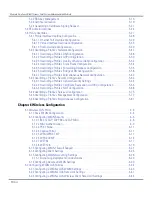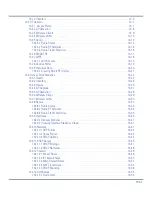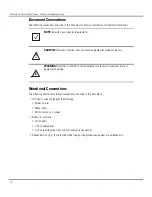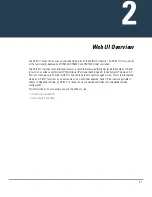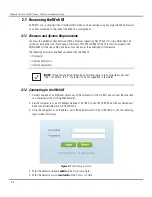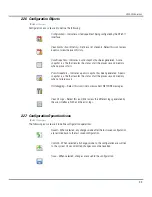
Motorola Solutions AP-6511 Access Point System Reference Guide
1-2
1.1 About the Motorola Solutions WiNG 5 Software
A WiNG 5 network uses Access Points to adapt to the dynamic circumstances of their deployment
environment. The WiNG 5 architecture provides a customized site-specific deployment, supporting the best
path and routes based on the user, location, the application and the best route available (both wireless and
wired). A WiNG network assures end-to-end quality, reliability and security without latency and performance
degradation. A WiNG 5 network supports rapid application delivery, mixed-media application optimization
and quality assurance.
Deploying a new Motorola Solutions WiNG 5 network does not require the replacement of an existing
Motorola Solutions wireless infrastructure. WiNG 5 enables the simultaneous use of existing architectures
from Motorola Solutions and other vendors, even if those other architectures are centralized models. A
wireless network administrator can retain and optimize legacy infrastructure while evolving to WiNG 5 as
required.
By distributing intelligence and control between the wireless controllers and Access Points, a WiNG 5
network can route data directly using the best path, as determined by factors including the user, the location,
the application and available wireless and wired resources. As a result, the additional load placed on the
wired network from 802.11n is significantly reduced, as traffic does not require an unnecessary backhaul to
a central controller.
Within a WiNG 5 network, up to 80% of the network traffic can remain on the wireless mesh, and never
touch the wired network, so the 802.11n load impact on the wired network is negligible. In addition, latency
and associated costs are reduced while reliability and scalability are increased. A WiNG 5 network enables
the creation of dynamic wireless traffic flows, so any bottleneck is avoided, and the destination is reached
without latency or performance degradation. This behavior delivers a significantly better quality of
experience for the end user.
The same distributed intelligence enables more resilience and survivability, since the Access Points keep
users connected and traffic flowing with full QoS, security and mobility even if the connection to the wireless
controller is interrupted due to a wired network or backhaul problem.
Even when the network is fully operational, outside RF interference sources or unbalanced wireless network
loading can be automatically corrected by the WiNG 5 Smart RF system. Smart RF senses interference or
potential client connectivity problems and makes the required changes to channel and Access Point radio
power while minimizing the impact to latency sensitive applications like VoIP. Using Smart RF, the network
can continuously adjust Access Point power and channel assignments for self-recovery if an AP fails or a
coverage hole is detected.
Additionally, integrated Access Point sensors in conjunction with AirDefense Network Assurance alerts
administrators of interference and network coverage problems, which shortens response times and boosts
overall reliability and availability of the WiNG 5 network.
Network traffic optimization protects WiNG 5 networks from broadcast storms and minimizes congestion on
the wired network. WiNG 5 networks provide VLAN load balancing, WAN traffic shaping and optimizations
in
dynamic host configuration protocol
(DHCP) responses and
Internet group management protocol
(IGMP)
snooping for multicast traffic flows in wired and wireless networks. Thus, users benefit from an extremely
reliable network that adapts to meet their needs and delivers mixed-media applications.
Firmware and configuration updates are supported within the network, from one Access Point to another,
over the air or wire, and can be centrally managed by the controller. Controllers no longer need to push
firmware and configurations to each individual Access Point, reducing unnecessary network congestion.
Summary of Contents for AP-6511
Page 1: ...Motorola Solutions AP 6511 Access Point System Reference Guide ...
Page 2: ...Motorola Solutions AP 6511 Access Point System Reference Guide 1 2 ...
Page 24: ...Motorola Solutions AP 6511 Access Point System Reference Guide 2 12 ...
Page 318: ...Motorola Solutions AP 6511 Access Point System Reference Guide 10 16 ...
Page 409: ...Statistics 13 49 Figure 13 31 Access Point Firewall Packet Flow screen ...
Page 433: ......




